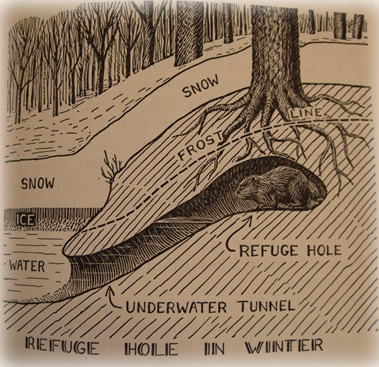BEAVER ECOLOGY
Beaver (Castor canadensis), America’s largest rodent, require an aquatic habitat for an underwater entrance to their lodges and to access food. Though all North American beaver are of the same species, beaver will either build a lodge or dig out a bank den to raise their young in, take shelter, and wait out the winter. |

|
The choice will be made based on water conditions. Beaver living in fast flowing rivers and streams that will not allow a beaver dam to be maintained simply dig a tunnel up into the bank. Usually they will add a few dead sticks on top of the underground den. These beaver are at the mercy of the river with regard to water levels. |
|
|
Here is the upstream end
of the same island we cut willow from.
Can you find the beaver bank den?
(photo left, mouse over for a closer look!)
Let’s paddle in a little closer.
Now it’s easier to find. (photo right) |

|
River bank dens are usually
not this conspicuous.
The den opening is well below the surface
as I’ve seen this particular den
during low water conditions
and the entrance is still not visible. |

|
Beaver residing in aquatic systems
that allow dams to be maintained or
have little or no current,
build lodges to reside in.
The following picture is our golden retriever
listening to the
beaver inside a winter lodge. |

|
Frank Conibear,
Canadian woodsman and trapper,wasn’t satisfied with naturalists’ answers to forest mysteries about the habits and actions of many animals, including the beaver. He observed animals in the wilderness and studied their cycles of abundance and scarcity.
In time he began to write stories about the animals he knew. In this book, The Wise One, he combined his unsurpassed knowledge of the beaver with a rare and natural gift for story telling. |
|
Illustrations by J.L. Blundell
throughout the book help explain
the story of the beaver and its relationship
to the other animals in the Canadian wild.
Here is an illustration of a typical bank den. |

|
The following is an excellent drawing
of a cross-section of a beaver lodge,
followed by a vertical look down at the lodge. |

|
Beaver usually live in family units, consisting of the older mated pair, young from the prior year, and young from the current year, called kits.
Breeding season takes place in late January through February. The two-year olds are evicted from the colony afterwards to relocate and seek mates of their own.
This migration of beaver usually occurs
with the breaking up of ice
in late winter or early spring. |

|
Once beaver become determined to claim a territory, they are very difficult to dissuade. If the activities of the beaver flood roads or damage property, the beaver usually have to be removed to prevent reoccurring damages.
True natural beaver predators in Wisconsin are few and far between. The list of North American predators includes mountain lions, wolves, river otter, wolverine, lynx, bobcats, and bears. Juvenile beaver are vulnerable to coyotes, eagles, large owls and snapping turtles as well.
|
 |
At times, beaver cause a significant amount of property damage by cutting trees, and flooding large areas also killing the timber. Culvert plugging is common, often causing roads to flood and wash out. Farmers here in Wisconsin with cropland bordering rivers often have fields flooded due to beaver damming up drainage ditches. |
That being said, beaver dam building resulting in modification of the natural environment
where human activity is minimal can be very beneficial. The ponds, wetlands, and meadows formed by
beaver dams increases biodiversity and improves overall environmental quality.
|

